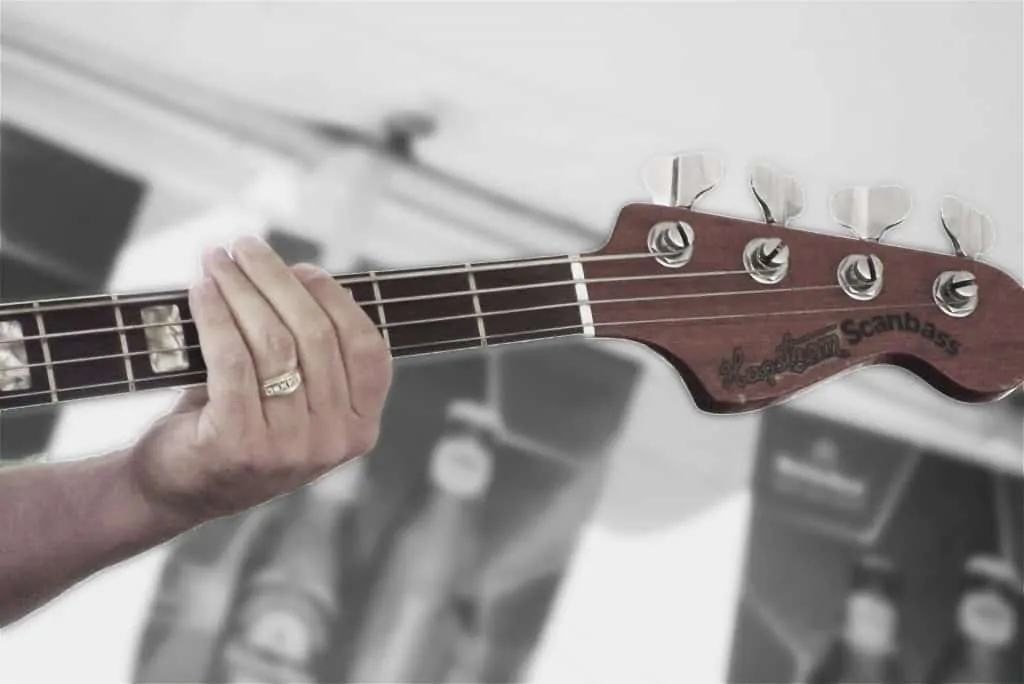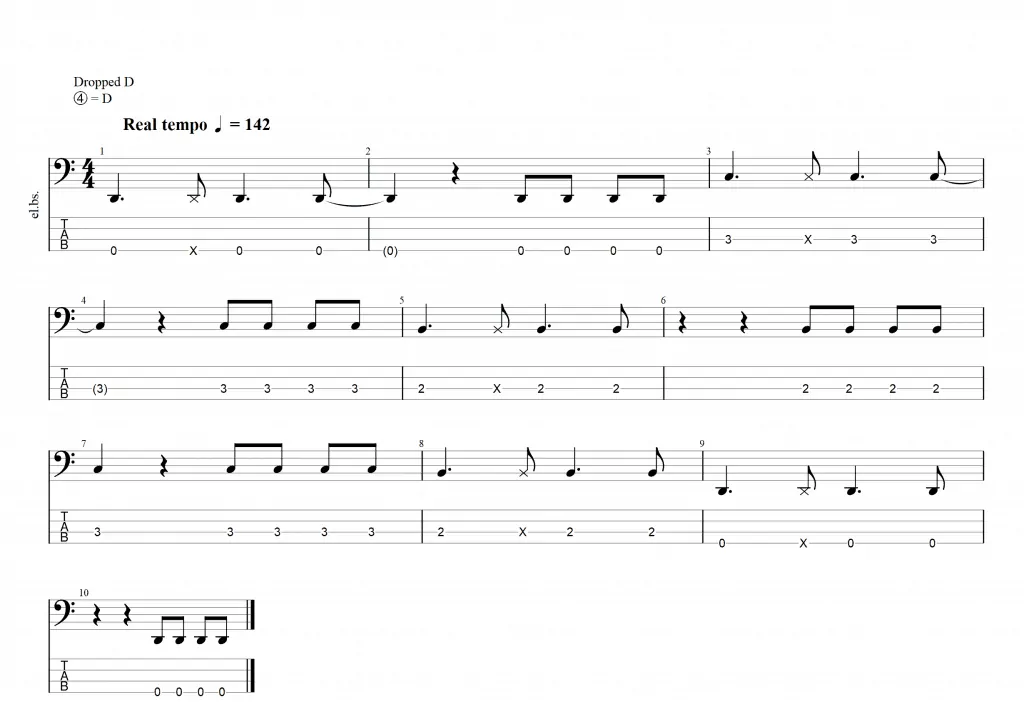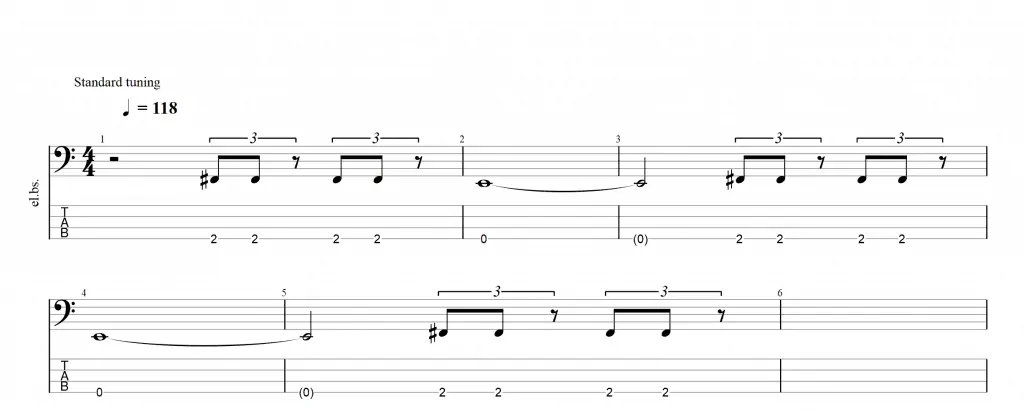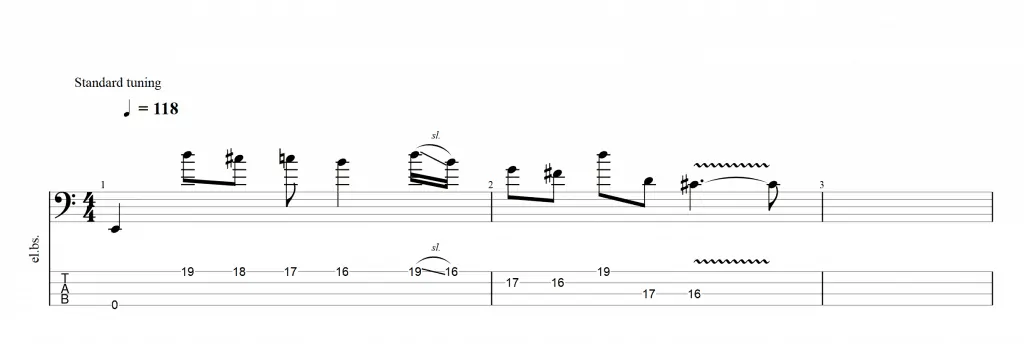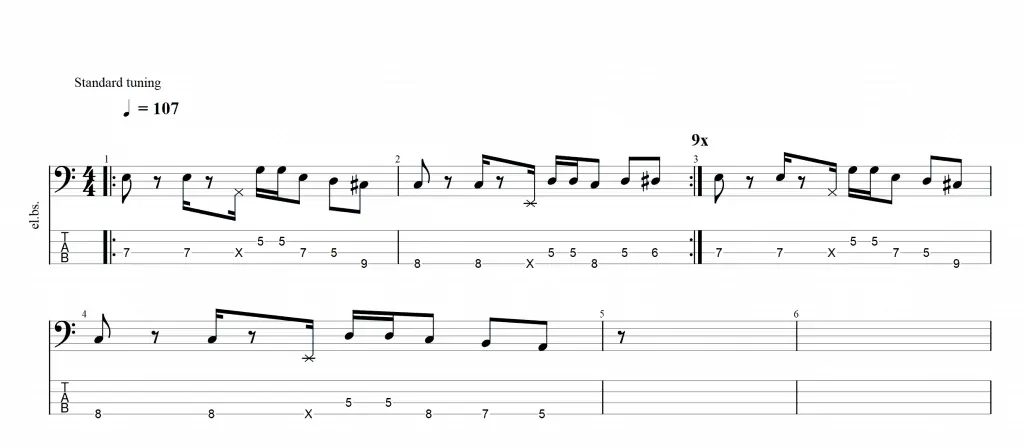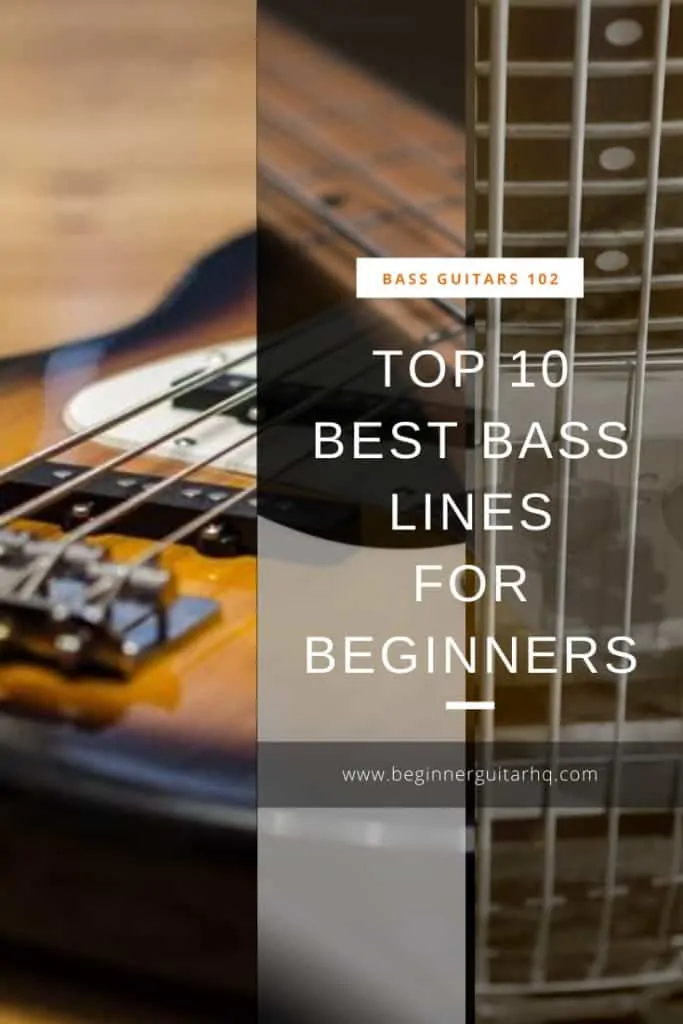I’m helping you learn and practice the top 10 bass lines for beginners. Instead of touching theoretical subjects, we’re going straight into the actual bass playing.
However, we do need to understand what is a bass line you can not only create one of your own, but also understand, play, and even improve over someone else’s.
If you chose to read this article, I assume you’re already into playing bass and have some skills under your belt, so, instead of going deep into how to play bass, let’s learn how to improve your bass playing fast.
Otherwise, if you’re looking into some extra instructions, you can check my previous bass. Let’s do a quick review: the bass guitar is the rhythmic foundation of almost any musical genre, and it gives shape to the harmonic foundation by accentuating the root note and giving way to the next note or chord in the chord progression.
So, the rhythm is the musical pulse, the beat most people follow with their feet, and the harmony is how every instrument and every melody combines together.
Overall, you’ll find on the list the best bass riffs to practice and improve your bass playing. I’ll try my best to share different songs with what you always find on other pages, songs you probably have already seen.
Contents
What is a bassline?
The bassline (also known as bass part or bass line) is part of a line played by an instrument that belongs to the rythm section. These instruments are the electric bass, double bass, tuba, cello, or keyboard (piano, synthesizer, electric organ, or Hammond organ).
You may know the bass line in popular music as riffs or groove. These are simple phrases or motifs that repeat throughout the song with minor variations.
Basslines are made of motifs, which are, in essence, recurring musical figures or a succession of notes that has some special importance or is characteristic of the song or composition.
The bassline holds the rest of the band together.
A bassline riff or groove often emphasizes the chord tones of each chord, which is either the root note, third note, or fifth note.
For example:
The guitar plays a major C power chord:
The bass may then play either the root note or the third or fifth note of the C major scale:
| C | Root |
| D | 2nd |
| E | 3rd |
| F | 4th |
| G | 5th |
| A | 6th |
| B | 7th |
| C | 8th (octave) |
As you emphasize the chord, you help define the song’s key. Then, the bass must also follow the beat ad aligns with the drums to create the rythm.
So, as a bass player, you must emphasize the root note, create the rhythm with the drums by playing with different musical figures, and help create harmony by giving way to the next note.
How to create a bassline
Let’s sum it up: the primary role of the bass is defining the harmonic structure by putting emphasis on the chord roots, oftentimes on the first beat. Aside from that, different styles of basslines help define the musical genre.
When you create a bassline, you must think of how to approach target notes. Target notes are the ones you, as a bassist player, are responsible to play.
Furthermore, it’s not only about how to approach target notes, but it’s also about how to walk the fret towards target notes. It means: which notes are you playing on your way to the target note?
While the chord root on the first beat is very common, there’re additional notes that are obligatory. Without them, you would lose harmony, rythm, or both. Often times, you would play notes on the scale, but not on the chord, towards the target note, in order to create a sense of momentum.
Other than target approaches, the bass has a third resource known as “skips.” A skip is when you mute a string to get a percussive sound. It adds life to your line and it’s great to precede a target note.
Let’s now review the most common types of bass guitar lines, and approaches to create those parts.
You can start building your own bassline by simply following the chords’ root notes on each beat. After you get a hang o the song’s tempo and chord progression, feel free to add all the creativity you want.
Bassline types
These categories are not written in stone. The boundaries are blurred, so you’re free to mix the different styles to create something truly yours.
Also, you can change the style and the approach within the same song. For example, you can change how you play one chorus and the other, as it will give shape to the arrangement.
So, these are general terms that aren’t intended to strictly define how you play bass. However, by understanding overall approaches will improve how you play bass guitar fast. It will also help you understand the best bass lines for beginners I listed below.
- Harmonical foundation
The bass’s priority is almost always to “make the changes,” which means being the base of the song’s harmonic structure.
Simply put, the bass remains steady with long-duration notes, usually with whole notes and half notes musical figures. It makes the chords fatter because it plays the root of each chord, oftentimes following the tempo of the kick drum.
For example, ina 4/4 tempo te bass plays the root on the first beat, and then the 3rd, 5th, or 8th the 3rd beat. The objective is to play the root note on each chord change.
Playing as a harmonical foundation means playing long-duration notes, which means playing a single note during various chord changes.
Remember a bassline doesn’t have to be complex, linear, or distinctive. It has to do its job, and there’s no shame in simplicity.
This kind of bassline is very common in modern pop-rock and rock ballads. Here’s an example:
- Play time
A bass player that “plays time” plays on every beat of the compass. It’s an approach that takes many forms: repeated notes, walking bass lines, alternating 5ths and roots, and more.
It also tends to follow the drum kick’s rythm. It creates more grove than playing the changes and it’s very common in jazz and rock & roll.
- Walking bassline
A bass that “walks” play time with a linear approach. It moves in either crotchets or 8th notes with a particular fill.
Beyond just playing the chord’s roots, it uses the chromatic scale to “walk” towards the target notes on the intended beat.
You would still play the root note on beat 1. However, now there’s a sense of journey from note to note. Often times, there’s a section of the “journey” on each compass; the journey itself completes every 4 or 8 compasses (a phrase) and then repeats itself with minor (if any) variations.
Beats 2 and 4 are particular points of tension for walking basses. They lead to resolutions on beats 3 and 1.
You can create tension playing notes that are outside of the song’s scale, and release it by playing notes on the scale and, better yet playing the root, 8th, 5th, or 3rd.
Lastly, a walking bass keeps a steady rythm. However, you might change it with an upbeat by adding a note lasting just a third of a beat.
This is common in country music, rock&roll, boogie-woogie, and jazz. Here’s an additional resource on how to create walking basslines.
Here’s a video tutorial further explaining the concept:
- Bass riff
This is a repeated lick that’s a short, melodic figure. The bass riff often becomes the main theme of the song, even the protagonist, while all the other instruments play around it. Famous bass riffs include “Come Together” by The Beatles, and “Money” by Pink Floyd.
Bass riffs are common in R&B, hip hop, and electronic music; as well as rock genres and classic rock styles.
- Stop time
A stop time bassline means the bass plays a short introductory rythm, often a rhythmic figure on the first beat, and then rest for a few beats. The melody would then play alone until the bass comes back.
It’s a sort of call and response thing, where the bass introduces and the rest of the instrument develop.
Stop time is very common in blues and jazz. It’s also a good resource for experimental rock, post-rock, and similar rock styles.
- Latin bass (also afro-cuban)
Latin bass styles (which includes Brazilian, afro-Cuban, Caribbean, and related South America musical genres) revolve around repeating traditional rhythmic patterns led by percussions. These rhythms tend to focus on the root, the 5th, and the octave.
The bass is also deep and repeats the same motif all over the song however following the melody.
Latin basslines are often syncopated. Syncopation is very common in dance music, and it occurs when a strong harmony begins on a weak beat.
Listen to Carlos Santana’s music if you want to understand syncopated Latin bass lines:
- Follow the lead
Probably the easiest basslines to create because they require no extra imagination from the bass player. However, this is often times the best choice, and your choice as the bass player is to choose the best way to enhance both the harmony and the rythm,
To follow the lead as the bass player means playing exactly what the lead guitar or rythm guitar is playing. This means, for example, playing the same riff or leak as the guitar, albeit on a different octave (commonly a lower octave). It also means following the lead guitar in exactly all of its notes and fills.
This is a very common kind of bass in almost every hard rock and metal genre. Here’s a great example:
- Bass solo
I know this is not a popular choice because it’s not at all easy to do. Bass strings are heavier and harder, and frets are farther in between. Even so, a bass can also solo, and a bassline can be a “bass solo.”
The bass solo is when the bass breaks character and plays more melodically. It expands its roles from solely defining harmony to following the melodies of the other instruments.
However, while playing bass, you must be responsible for the rythm. If you don’t, the other instruments will begin slacking.
Take your bass pedals with you if you’re planning to play a bass solo.
Remember, these are general terms. What you can get out of this is how you can approach each bassline and, what’s more, how each bassline was composed so you can recreate-it faster.
Before we go on, let’s do a quick review of phrases and cadences, as I’ll be mentioning these concepts on the list.
Phrases and cadences on your bassline
A phrase is a series of notes that feel complete within the sound and would feel complete without the rest of the song.
A bassline phrase, just like a guitar phrase, would follow through a set of compasses and then give way to a cadence before it repeats itself.
The cadence is the chord progression that ends a phrase, usually on the 5th note of the scale the song is written in. Most often than not, the 5th is also the 5th note of the first note of the rest of the verse, the one-note or chord that starts a phrase.
So, let’s say the song is on C major; the first chord of the chord progression is C5; the first note of the bass is C.
Then, the bass can follow on the C for a set of compasses until the cadence follows through. The phrase + the cadence would normally give a number of pair compasses in a 4/4 standard time.
Here’s an example:
A simple bass line with the C note (root), where the cadence goes to the G note (5th). Listen to the audio here:
Phrases and cadences work like the punctuation of music. Phrases tell about a cohesive musical section, while cadences put an end to said section to introduce the following one.
A cadence may end a verse to give way to a chorus or end a chorus to introduce a bridge. A cadence may also split a section into two or more parts, each one playing with more or less intensity than the previous one.
Lastly, a cadence may also divide one phrase to the next because that’s where the singer can rest the voice.
If you need some help with musical figures (the whole time, half time, crotchet,…), take a look at this guide.
With this newfound clarity, let’s now dive into the top 10 best bass lines for beginners.
Top 10 bass lines for beginners (with tabs)
I chose the following top 10 bass lines for beginners because I believe learning and understanding them will help you improve how you play bass guitar fast.
Practices make the master, so the question is what to practice. These lines are easy to learn, easy to play, and will give you some great ideas for your own songs. More so, you will understand how basslines and how each bassline type works.
I’m giving you a cheat sheet to learn each of the lines. Remember, I’m not teaching you complete songs but the important, most recognizable, interesting and fun parts. Even so, by learning this, you’ll probably play through the rest of the song.
What I’m featuring here are famous, well-recognized songs. You might already have an inner desire to play them, but you just didn’t know-how.
These are the basslines you’ve always wanted to learn.
I’ll be sharing the bass tabs alongside the sheet music and an audio file. If you’re unsure as to how to read bass tabs, take a look at this Beginner Guitar HQ guide.
Keep in mind a bass tab is the same as a guitar tab minus two strings (the 1st and the 2nd).
And, lastly, remember this is for beginners, so don’t expect to find any Tool or Rush on the list. Some of these are0 iconic basslines, others are just personal taste, and all of them are good for beginners (some easier than others).
Money – Pink Floyd
Money is part of the iconic album The Dark Side of the Moon by the British band Pink Floyd. It’s the second single of the album, which premiered in 1973 and has sold over 45 million records worldwide.
The song plays in a 7/4 time signature, while the guitar solo and the outro runs on a 4/4 tempo. Pink Floyd’s frontman and bass player, Roger Waters, created the main bass riff, which comprises most of the song. More so, he also wrote the lyrics.
Guitar player David Gilmour created the chord progression as a twelve-bar blues in the B major scale.
And, lastly, the bridge giving way to the guitar solo has a 4/4 compass plus a 6/4 compass.
The first thing you need to understand how to play a 7/4 time signature. A 7/4 is an odd time signature where you can count 7 beats before the compass ends or before a musical motif repeats itself.
If you need to know, 7 tells how many beats to count, while 4 tells you in which musical figure you must count it. In particular, 4 means crotchets.
The 7/4 has three possible patterns:
- 2 beats + 2 beats + 3 beats each measure;
- 3 beats + 2 beats + 2 beats each measure;
- 2 beats + 3 beats + 2 beats each measure.
In particular, Money’s bassline runs with 2+2+3. It means you can count the bassline like this:
One, two – One, two – One, two, three.
The key to playing on time is counting the subdivisions of each compass until it feels effortless and natural for you.
At first, as you begin playing and counting, you will fill this time signature requires an extra effort from your part. But as you become more comfortable with it, you will no longer think of the odd pattern.
What I want to teach you is the verse lines, which is the main motif of the song. Learn this, and the rest of the song will be a breeze for you.
Here’s the gist of it:
Listen to the audio here:
Special notation:
- The point right next to a musical figure is a dot. A dot increases the figure’s duration by half.
It doesn’t sound quite right yet, does it? Let’s add some swing to it. More so, let’s add the repetitions so I can tell you how to play the whole verse section.
Special notation:
- The point right above or below a musical figure is a Staccato. It means you must shorten the note and mute it before the next one begins.
- The arc connecting one note to another is a Legato. It means you play these notes without an appearing separation between them.
Lastly, while I’m sharing you the audion on a 120 BPM because it’s easier, you can play Money at 124 BPM with your metronome.
I picked Money because it’s one of my favorite songs and it’s an amazing bass song. The bassline was created first, and everything else followed. So, if you want to know how important the bass can be and how to create a song were your instrument of choice is the leader, this is the song to listen.
More so, I made it easy for you to understand the 7/4 odd tempo. It can give you more tools to compose your own themes.
Crazy Train – Ozzy Osbourne
Crazy Train is a heavy metal song by former Black Sabbath frontman Ozzy Osbourne. It debuted on 1981’s album Blizzard of Ozz and speaks about how Ozzy felt after bein kicked out of Black Sabbath.
The bassline starts with a stop-time section and then evolves into a walking bass riff.
What’s I’m going to teach you is the intro riff plus the verse riff. Let’s review the intro first:
And, then, the verse goes like this:
See how it only uses 8th notes on the line? It’s all about feeling the spaces in between the notes, the silences.
I picked Crazy Train because it’s easy and it says “I’m classic Heavy Metal” all over its bass riff. It will help you capture the magic of classic heavy metal and give you some ideas to create your own rock songs. With a 134
Lastly, I have to add this is a simple 4/4 song with a 134 bpm.
Another One Bites The Dust – Queen
Why is this also a base centered-song? Because it was Queen’s bassist player, John Deacon, the one who composed the theme.
Another One Bites the Dust belongs to Queen’s 1980 album The Game and became Queen’s greatest success with over 7 million copies sold worldwide.
The song reached number 2 on Billboard Hot 100 R&B and Disco charts, and reached number 7 on the United Kingdom charts. In the USA, Argentina, Canada, Spain, Chile, Costa Rica, Guatemala, and other American countries it reached number 1.
The song was so successful Queen decided to abandon classic rock to step into dance and disco genres. The result was the album Hot Space, which has the song Under Pressure.
The funny thing is Queen member didn’t think the song was good enough for the album, much less to be single. It was former pop king Michael Jackson who convinced them to share the song with the world.
I’m teaching you the verse basslines, obviously. These are a “play tempo” kind of thing with a shade of walking bass. See, it has an “upbeat” every other compass to complete a phrase.
John Deacon made an apparently simple 8th and 16th notes riff with a powerful, disco tone and a definite “staccato” feel and created a worldwide recognized song.
Let’s review the line:
Special notation:
- The triangle below a note -the one pointing below – means it’s a heavily accentuated note.
- The triangle below a note -the one pointing right – means it’s an accentuated note.
- The point right above a musical figure is a Staccato. It means you must shorten the note and mute it before the next one begins.
The verse bassline has a variation every 6 compasses to end the phrase with a cadence. The cadence verse (two compasses) goes like this:
Another One Bites the dust follows a 4/4 tempo with 11 bpm. The trick is to get that dry, funky sound. Deacon used mostly Music Man and Fender P basses.
More so, he struck the strings very close to the bridge pickup while resting his thumb on the middle pickup. That quick trick gives you a much fatter sound.
Slither – Velvet Revolver
Let’s make a recess from classic rock and go forward in time for some modern hard rock. Slither is the second single of American rock band Velvet Revolver’s debut album, Contraband.
The song won 2005’s Grammy Award for Best Hard Rock Performance, a price its singer, Scot Weiland, had already won with his previous band, Stone Temple Pilots, for 1994’s Plush.
By the way, the rest of Velvet Revolver’s Band are Guns N’ Roses former members after being kicked out by Axl Rose. It includes bass player Duff McKagan, guitar player Slash, and drummer Matt Sorum.
I have to add Scott Weiland passed away in 2016. May he rest in peace.
Slither’s bassline is a riff all the way through. More so, it has a “follow the lead pattern” on the verse, and turns into a play tempo on the chorus.
I’ll teach you the juicy parts, which is the main bass riff and the chorus. You need to tune the 4th string in D. The song’s BPM is 142, however, I’m sharing the main riff with 100 bpm so you can practice.
The main riff goes like this:
The riff repeats all over the song and its made only of 8th notes. Even more, it doesn’t have a “cadence” per se, because, in this case, the cadence is presented on the guitar’s riff and the drums. However, the bass keeps the same line and the same intensity from top to bottom.
The chorus develops into a simplified line with the same chord progression. It goes like this:
Special notation:
- The “x” means a muted noted.
- The arch connecting one note to the next means it’s a tie note. You would extend the duration of the note as the sheet says.
- The note inside a pair of “( )” means is a ghost note: it’s just a continuation of pressing a note on the prior compass.
- The point right next to a musical figure is a dot. A dot increases the figure’s duration by half.
The last thing to do is try to imitate Duff McKagan’s sound. He uses mostly Fender P/J special basses, with are Japan and Mexico-made Fender basses with a Jazz neck and a Precision body. Here’s a budget alternative.
I can also recommend you check Duff McKagan’s signature bass, which is of my favorite all-time basses.
Beat It – Michael Jackson
This is my favorite Michael Jackson song, and this one features a tasty, catchy bass riff.
Beat It was written by Michael Jackson for his sixth solo album, 1982’s Thriller. Eddie Van Halen recorded the guitars for the song.
It’s the third single of the album and one of the most successful songs of all time. It won two Grammy awards (Recording of the Year and Best Male Rock Performance).
Let’s share the main riff, which is also the chorus. The sheet I’m giving you has 120 bpm so you can practice, bu Beat It has 132 bpm. You can practice it afterward with your metronome.
The verse develops into a more steady playtime kind of bassline. It goes like this:
Similar to other songs, the bassline doesn’t have cadence.
Du Hast – Rammstein
Let’s move onto some heavier rock, this time by one of the most successful industrial-rock bands of all time, Rammstein (from Germany).
Du Hast (which means “You Have”) is part of Rammstein’s 1997 Sehnsucht album. It gave the band their first Grammy nomination.
Du Hast’s bass works like a play tempo. It follows the drum very closely.
Let’s start with the intro line, which is also the chorus. The riff repeats for six compasses and ends the phrase with a cadence one single compass, which creates an odd time.
And the verse riff is also a play tempo, albeit with fewer notes, less intensity. It goes like this:
The real BPM of Du Hast is 125. It’s not fast, nor slow, so you can practice with the song without issues.
The Resistance – Muse
The Resistance names the fifth album of British experimental rock band Muse. The Resistance premiered in 2009. Until the year 2018, The Resistance has sold over 4.5 million copies worldwide, which includes 1.2 million copies sold in the USA.
Muse’s bass player, Christopher Wolstenholme, tends to create fat, melodic basslines for the eccentric guitar lines of frontman Matt Bellamy. The Resistance follows the trend with a riff that sounds complex but, in truth, it’s bassline for beginners.
I choose Resistance as a top bassline for beginners because I want to show you how a bass solo can work a the main riff. See, the pre-chorus bass riff is a solo, which is what I’m teaching you right now:
Special notation:
- The line connecting one note to the next means, as well as the arc connecting one note to the next, are forms of a slide.
The rest of the song is easier as it follows a play tempo. I’m teaching you another way because I want you to learn more things.
- The chord progression in the chorus is as follows: C – G – A – G – F. The tempo is always 8th notes.
- The chord progression in the verse is as follows: D – C – F – E. All notes are 16th notes.
The Resistance’s BPM is 135. I gave you the example on 125 so it’s easier for you to practice.
For Whom the Bell Tolls – Metallica
For Whom the Bell Tolls by Metallica was written by one of the best rock bass players of all time, Cliff Burton (may he rest in peace).
It’s part of Metallica’s second studio album, Ride The Lightning. Burton created the famous intro by recording 3 layers of bass, 2 of which had distortion.
I chose this song because I’ve never known a rock bass player who doesn’t want to learn how to play For Whom the Bell Tolls bass intro.
So, as I said, the intro contains three bass layers. The first layer follows a play tempo like this:
Special notation
- The note inside a pair of “( )” means is a ghost note: it’s just a continuation of pressing a note on the prior compass.
The distorted bass goes like this:
Special notation:
- The line connecting one note to the next means, as well as the arc connecting one note to the next, are forms of a slide.
- The triangles below a note mean it’s vibrato, so you would have to press the note gently up and down make slight changes on its tone.
Every time BUrton played live (as well as current bass player Robert Trujillo) he does minor variations instead of the vibrato note. Feel free to experiment on your own!
Would? – Alice in Chains
Alice in Chains is one of the top 90’s grunge bands, alongside Nirvana, Pearl Jam, Candlebox, and Soundgarden. Would? is a single from their 1993 album Dirt. The song is packed with feeling and talks about what brought the singer’s Layne Staley demise: drugs.
I could have chosen something more popular like Nirvana’s Come As You Are, Stone Temple Pilots’ Plush, or Pearl Jam’s Even Flow. But this is one of my favorite songs, and it’s great for a bassist player.
I’m also showing you this to make an example of a beginner bassline with a different tunning than “drop D” or “standard tuning.” In this case, you would have to tune your bass a semitone lower:
Eb, Ab, Db, Gb.
I’m teaching you the main bass line, which works as a walking bass. It goes like this:
Special notation:
- The arch connecting one note to the next means it’s a tie note. You would extend the duration of the note as the sheet says.
And then, the chorus bass evolves into a play tempo bassline. Here’s the tab:
Let’s move on to my final choice.
The Adventures of Rain Dance Maggie – Red Hot Chilli Peppers
There’s no way I could finish any bassline list without featuring some Red Hot Chilli Peppers. Their bassist player, Flea, is one of the greatest bass players of all time. He rocks his riffs with a fretless bass and a definitive funky style.
The Adventures of Rain Dance Maggie is the first single of their 2011 I’m With You album. It’s the first single released with the guitar player Josh Klinghoffer after the departure of John Frusciante.
I picked this song because it’s an easy to play bassline from Red Hot Chilli Peppers. However, other iconic basslines for beginners from the band are Otherside and Under the Bridge.
The first verse line works like a bass riff and a walking bass at the same time. The phrase goes for 18 compasses, and then, there’s a cadence on the compass number 20. As you’ll see, those last two notes are how the bass walks towards the first target note of the chorus.
More so, the last two notes of every other compass (before the riff repeats) are how the bass walks towards the root note, which is E.
Keep in mind the number of repetitions is not the same in the next sections. However, the cadence before the chorus is the same.
The chorus – walking bass – has 8 compasses per phrase, where the last 4 compasses of each phrase represent the cadence. Here’s how it works:
You would repeat that whole line two times to get the complete chorus.
Final Considerations
We’ve all seen a pattern here, a pattern we’ll find in many iconic basslines and may iconic songs: popular, successful bass lines can be simple and are usually made of pure 8th notes using 16th notes as an upbeat.
Additionally, professional bass players love to play with the octave note to fill their lines, as well as using chromatic scales to walk towards target notes. That means you can simply play the note half a step-down or up the target note, even if it’s not on the scale, and get an amazing result.
The truth is, for bass, less is more. As your job is to maintain the rhythm and create the harmonical foundation, sometimes, when you try too hard, you’ll end up ruining the song. It’s hard to know exactly what to play as a bassist player and keep the balance between too simple, too much, and just right.
As a general rule of thumb, follow your intuition, not your logical mind and certainly not your ego. See how the pros did it in these top 10 bass lines for beginners, and decide how you can do it yourself.
And, lastly, practice these songs. Hell, practice many songs, and play them on your guitar as well.
Do you have any questions, comments, or songs you would have added? Leave it on the comments below!





